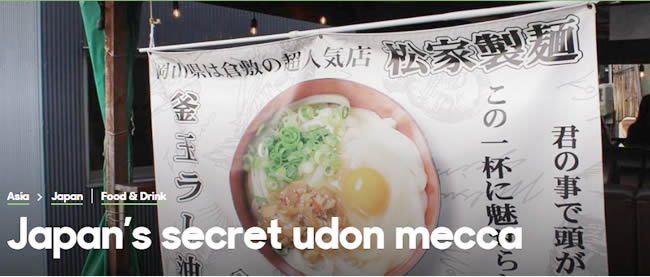先日から「Japan’s secret udon mecca – 秘密のウドン聖地」を読んでいます。

・「秘密のウドン聖地」(1)
・「秘密のウドン聖地」(2)
・「秘密のウドン聖地」(3)
・「秘密のウドン聖地」(4)
・「秘密のウドン聖地」(5)
・「秘密のウドン聖地」(6)
・「秘密のウドン聖地」(7)
Matsuka Seimen produces between 50kg and 75kg of udon each day.
松家製麺はは一日に50~75kgのウドンを製造する。
Taichi pours the flour and uchiko starch into the kneading machine and adds water.
タイチさんは小麦粉と打ち粉を生地こね機に注ぎ込み、水を加える。
After the dough has come together and has been kneaded for about seven minutes, he releases the dough particles out of the handled hopper that plucks the dough out of the kneading trough and drops it into plastic tubs where he mashes it down by hand.
7分ほど捏ねて生地がまとまったらホッパーにうつし、手でこねるための鉢に生地が落とされていく。
particle「分子、粒子、小片、極小量、みじん」。
hopper「跳ぶ人・物、ホッパー(じょうご型の大きな容器で下に開閉口があるもの)」。
pluck out of~「~から(不要なものを)引き抜く」。
Next, he covers the dough with a clean cotton cloth, dons new socks on his feet, and kneads the dough for a few minutes more by stepping all over it in a rhythmic fashion, as is traditionally done.
次に清潔なふきんで生地を覆い、伝統的な方法―― 新しい靴下を履いた足で更に数分間、リズミカルに生地全体を踏んでいく。
don「着る、履く、羽織る」。
in a rhythmic fashion「リズミカルに」。
The dough is stored in the tubs in the walk-in refrigerator to rest until the next day.
その後、鉢に収められた生地は、大きな冷蔵庫で翌日まで寝かせるのだ。
Because the dough is too hard to roll entirely by hand, it is first rolled by a machine.
生地は全ての工程を手打ちするには硬すぎるので、最初は機械で打っていく。
It’s later rolled by hand to add texture and finally made into noodles by being put through a small cutting machine right before boiling.
後から手で打つことにより食感を良くし、最後に茹でる直前に麺切り機で切る。
足でお客に提供する食べ物を踏む、というのは、外国人から見ると不思議な方法だったかもしれませんね(笑)。
我が家でも鍋のあとのウドンとして、足踏みウドンを作ってみたんですが、かなりコシが強くて美味しかったです。
もう適当に中力粉とぬるま湯と塩を混ぜて、それをビニール袋でくるんで10分くらい足踏み。
それを鍋を始める前に作って冷蔵庫にテキトウに寝かせて、数十分後に食べただけですが、それでも打ち立て(?)は、スーパーの袋麺より数段良かったです。
そんなテキトーでも美味しいんですから、松家さんの作ったウドンは本当に美味しいでしょうね。
理由は単純明快!「少ないコストでしっかり楽しく学べるから」。
私自身の経験(高機能でビックリ)をびっしり書いていますので、良かったら読んでみてください。
下のバナーからどうぞ!






